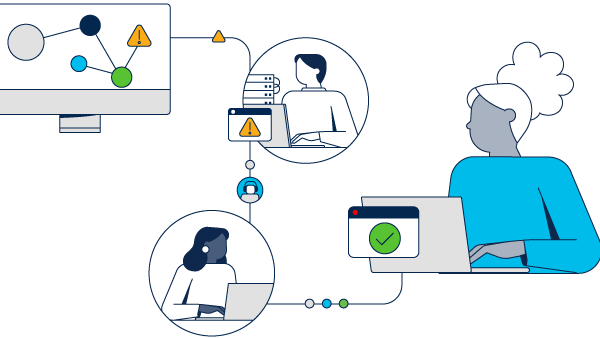Why is disaster recovery important?
Unexpected disasters can result in outages that impact networked IT systems. Cyberattacks, tech and equipment failures, natural disasters, and power outages are examples of disasters. The most important part of disaster recovery is having a safety plan in place that will help minimize disruption of business operations, customer frustration, data loss, and expensive recovery costs. Developing a plan beforehand reduces chaos during an event, when response time is critical.
Cisco Crisis Response global relief response teams respond in the event of an emergency such as a natural disaster or humanitarian relief crisis.
Cisco Talos cybersecurity response teams are professionals who can assist in the event of a security breach such as a cyberattack. This emergency task force assists with active incidents and provides proactive services to strengthen cybersecurity resilience.
What are potential impacts of a disaster or attack?
Cyberattacks are disasters. Just like any disaster, some of the impacts due to downtime from a disaster include:
- Impact to your organization and your customers' organization due to system downtime
- Loss of customer confidence from systems outages Impact on brand integrity
- Loss of employee confidence
- Diversion of resources from business-critical projects Financial loss such as reduction in stock price
- Subject to legal action, due to reliability issues in your service level agreement (SLA)
- Revocation of security accreditations
- Other unforeseeable impacts to the business
What is an IT disaster recovery plan?
We encourage organizations to develop a disaster-response and recovery plan, a set of well-documented policies and processes to follow in response to security incidents and other disruptive events. The purpose of a disaster-recovery plan is to help you mitigate the impact of events and resume operations as quickly as possible. Make sure it is up to date and tested. The following are detailed points to consider when generating your plan.
What is included in a DRP?
An plan often includes:
- Recovery time objective (RTO)
- Recovery point objective (RPO)
- Personnel involved and their roles
- Inventories of equipment, hardware, software, networks, and systems
- Data backup and recovery procedures
- Steps to restore and recover systems
What is the difference between BCP and DRP?
Though sometimes used interchangeably, business continuity planning (BCP) is different from disaster recovery planning (DRP). BCP focuses on keeping all aspects of a business running after a disaster, while DRP is an essential technology component of a BCP for recovering IT systems after a disaster.
What is the 3-2-1 rule for data backup?
The 3-2-1 rule is a data backup and disaster recovery strategy for maintaining three complete copies of your data on two different types of storage, with one physical copy stored offsite. A backup and restore strategy is an important element of an emergency preparedness checklist.
